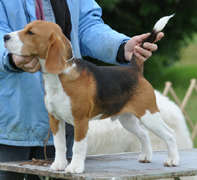
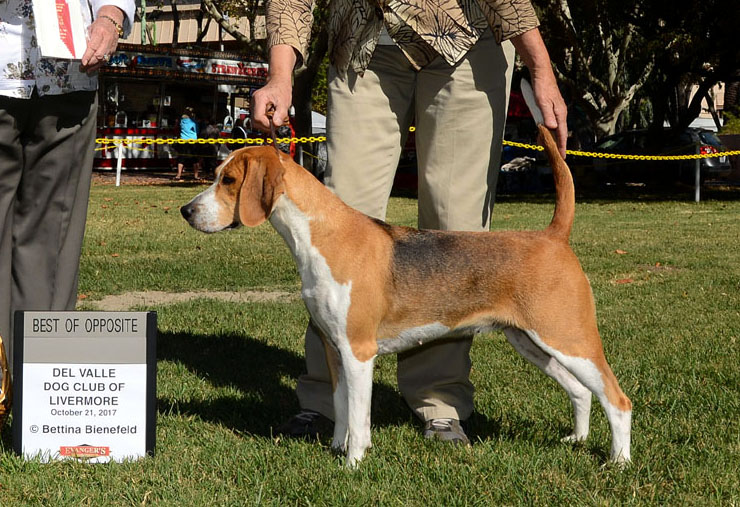
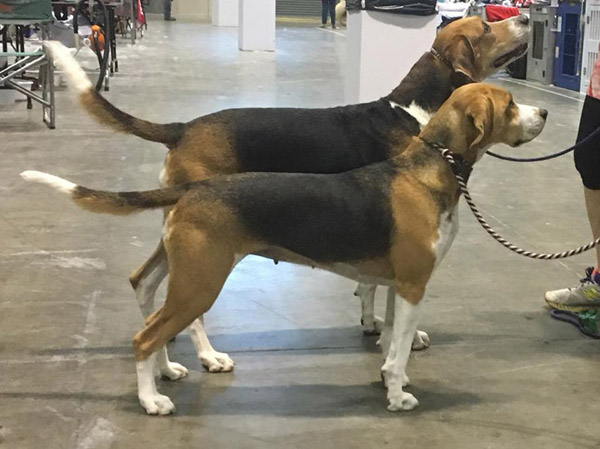
Blythmoor Harriers
|
Puppies
(past and upcoming) |
|||
If you have questions about Harriers, contact me at Margie@blythmoor.com.
Text or phone 971-218-0064 or see us on Facebook
Dogs currently available are noted on the "Current Harriers" page



A 141/2" beagle................................................a 21" Harrier bitch........................................................................................Harrier and Foxhound side by side, both average height for their breed.
Beagles are a maximum of 15", considerably smaller than Harriers, which are a minimum of 18" and up to 22" . Harriers should more closely resemble an English Foxhound but smaller. The English Foxhound standard does not give a size range, but generally a 24" dog as considered appropriately sized.
Harriers do not look like the typical Beagle that you see in the U.S. While they may resemble some of the Beagles used for hunting in the UK, they should closely resemble the English Foxhound. Visually a big indicator is tails. Beagles almost always hold tails at 90 degrees. Foxhounds and Harriers typically carry tails a bit lower (3rd picture) and will raise them when moving. Beagles are obviously shorter than Harriers, and most Foxhounds are noticeably bigger. Pictures of packs in the UK show the range of size in the Harrier. Body, head structure, leg length and tailset all make them very much different from Beagles. All three breeds should have a good amount of substance and structure that gives them the ability to run with ease over distance.
NOTE: There is a misconception out there that Harriers do not have dewclaws. Like most breeds, they most certainly do. Many breeders remove dewclaws and this must be done at about 3 days of age. I have chose recently to stop removing dewclaws. It is a purely cosmetic procedure, and unnecessary. Surely does not affect their status in the show ring. Dewclaws are generally mentioned in AKC standards only in breeds that require both front and rear or double dewclaws to be present. For some general information on dewclaws, try this link. http://www.mcrehabilitation.com/blog/the-function-of-dewclaws-101
My Australian import has typical Harrier dewclaws and he finished his Championship easily.
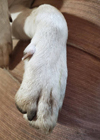
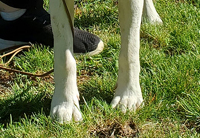
HARRIER COLORS
ALL Hound colors are acceptable in Harriers and it is not regarded as important. Mostly you'll see (left to right) Red/White, Lemon/White, and tri's -- both faded and dark.
There will be varying amounts of white on any of those color patterns and while you may have a favorite, judge's don't consider color.
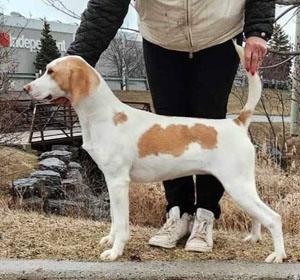
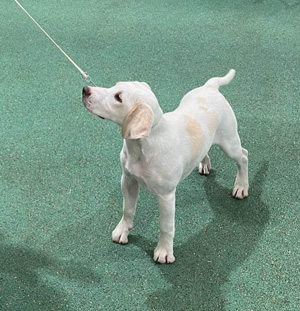
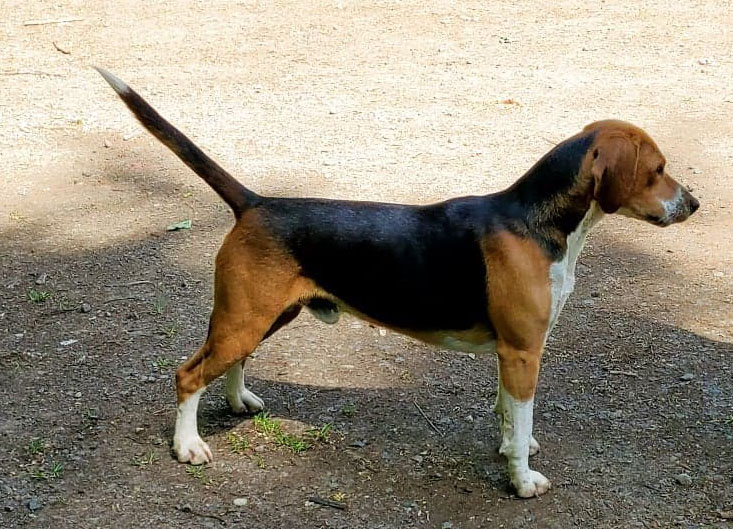
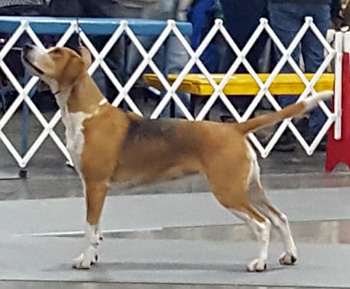
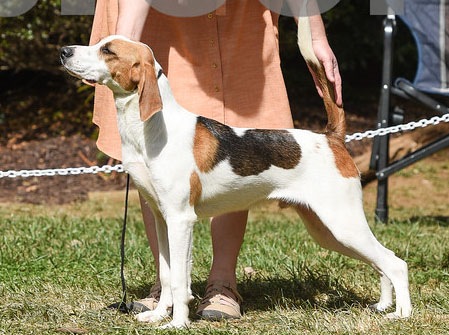
************************************************
EARLY FAMILY PICTURE
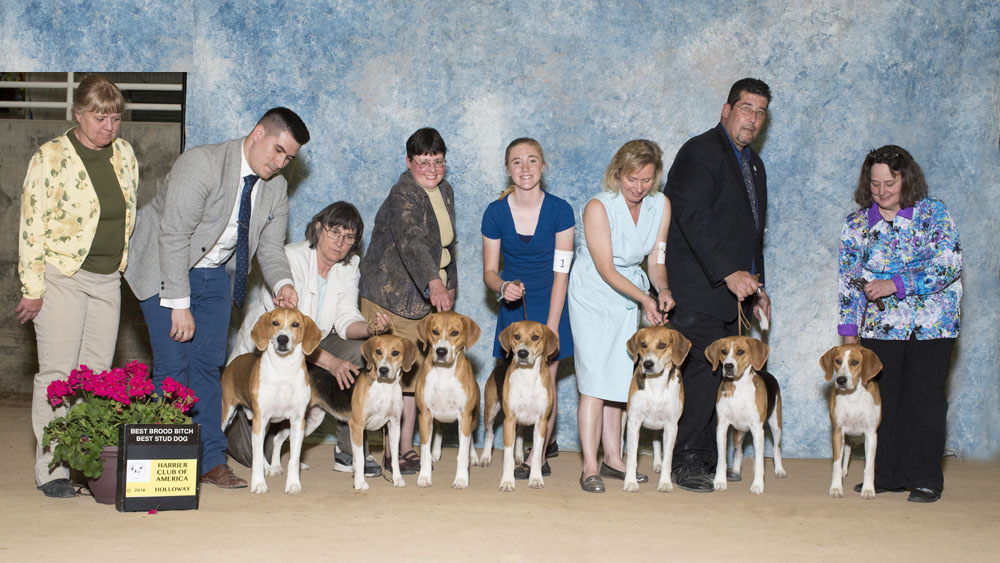
Blythmoor Hounds at the National Specialty 2016. Sire/dam on the far left (Bramble and Chance} , then littermates (GCHS Chase, GCHB Monroe, Baron, Emmy and GCHB Yahtze).
All of the kids became CH's and ranking dogs. Sister Stella (not pictured) is also an AKC and UKC CH.
******
I started in hounds with a couple of delightful Beagles several years ago but Labradors were my main breed. After several years of showing Labrador Retrievers and occasionally Beagles, my love of hounds eventually brought me to Harriers, which I have now had since 2006. All my dogs have always been family companions. I typically breed one litter a year (or less).
According to a survey in about 2016, there are only about 100 Harriers in North America. There still are not very many and very few active breeders.
Harriers are delightful dogs and make great family companions. While hounds tend to get a bad rap, they are great family dogs! Typically they love children (and everyone else).They are friendly with all other breeds and love sleeping in piles. Harriers are no more prone to run off than many other breeds. A normal fence will keep them in. Some like to dig. As with all breeds, some bark/howl a lot and some don't. I have found them very easy to live with and train -- far less chewing overall than most Labradors. They like to run, and then spend time on the couch. Overall a great family dog that is often overlooked because of the undeserved reputation of hounds. Reality is that hunting hounds are very well trained and must be willing accept direction in the field. They must also be friendly... and not prone to chase off after any scent that comes along. As with any breed, training is a must, but it isn't that difficult.
And they should LOVE everyone! Never dog aggressive. Good with children. Tolerant of the family cat.
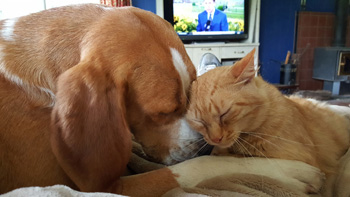
***********
Member of the Harrier Club of America